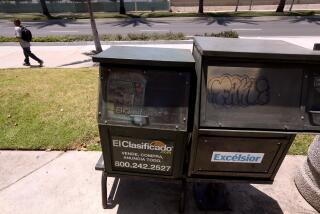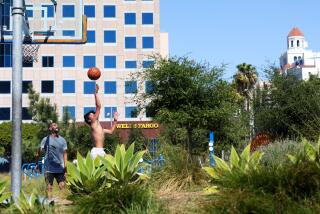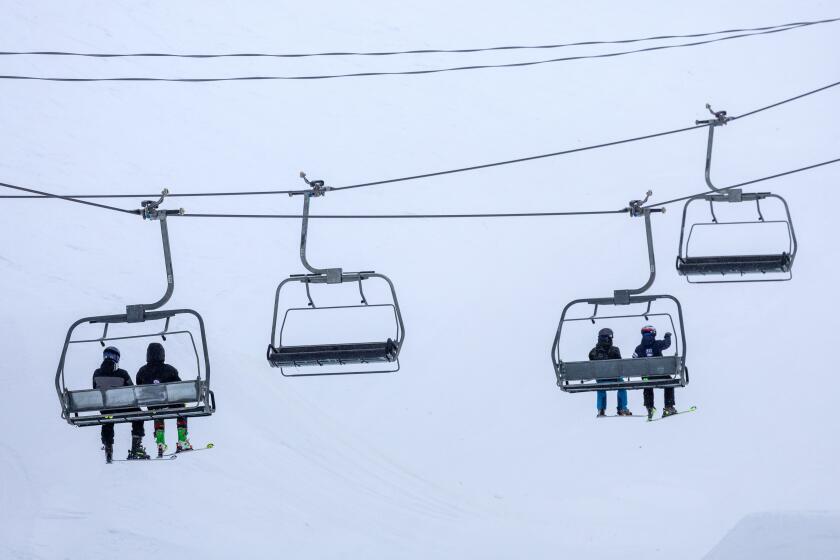New Magazine Hopes to Fly Where Others Have Folded
- Share via
Not long after a magazine called South Bay Living folded June 1, another publisher stepped forward with plans for a new magazine to be called South Bay Lifestyle.
Undaunted by the demise of South Bay Living after just four issues--and the failures of two previous magazines that catered to local readers and advertisers--publisher Steve Sheanin is convinced that the South Bay is fertile ground for the right magazine.
For the record:
12:00 a.m. Aug. 7, 1988 For the Record
Los Angeles Times Sunday August 7, 1988 South Bay Edition Metro Part 2 Page 10 Column 1 Zones Desk 1 inches; 23 words Type of Material: Correction
A story in Friday’s South Bay section misidentified one of the co-founders of South Bay Living magazine. The magazine was founded by Mary Gallant and Linda Buck.
Sheanin said the earlier magazines failed not because of lack of interest but because of a variety of unfortunate circumstances that he said have no bearing on his new magazine. He said South Bay residents want to read about people, places and issues affecting their home communities.
“The South Bay is very much a community unto its own,” agreed editorial adviser Carolyn Ryan, one of eight staff members Sheanin has hired. The South Bay’s casual, beach-oriented life style creates a readership distinct from the whims of the trendy Westside and the urban energy of downtown Los Angeles, staffers said.
Affluent Population
Whatever their interests, the South Bay’s generally affluent population of about 1 million offers just the kind of readers that are the mainstay of city and regional magazines nationwide, industry sources said.
A survey commissioned last year by the City and Regional Magazine Assn. showed that the readers of its 40 member magazines were highly educated and affluent, an audience advertisers want to reach. About one-third of the readers had graduated from college or done postgraduate work, and more than 70% had incomes of $40,000 or more, according to Brandi Sullivan, executive director of the Alexandria, Va.-based magazine association. The new magazine is not a member.
Los Angeles magazine, which dates back to 1960 and is one of the oldest city magazines, reports that its readers’ average household income exceeds $94,000. With a paid circulation of about 172,000, it is also one of the largest city magazines nationwide, according to spokeswoman CG O’Connor.
City magazines can be big moneymakers. Although Los Angeles magazine officials declined to disclose revenues, an information service called Leading National Advertisers/Publishers Information Bureau reported that the magazine took in $12,336,950 in advertising revenues in 1987.
Sullivan said it is unusual for a metropolitan area to have more than one city or regional magazine. The Los Angeles area, however, seems to be an exception, with two in Orange County alone. Among the regional publications are Orange Coast Magazine, Orange County Magazine, Valley Magazine, L.A. West, L.A. Style and Southern California Home and Garden.
There are so many population centers in the Los Angeles area that the region may be able to support a variety of local publications, industry sources said. As the region becomes more heavily populated and freeway routes more congested, people are eager to find out about things to do in their home neighborhoods, they said.
Sheanin, a 47-year-old entrepreneur with a waxed handlebar mustache, said the first issue of South Bay Lifestyle is due in November. He is so sure that the South Bay is ready for a magazine on the local life style that he is financing it with his own money.
In an interview in his office in Santa Monica, Sheanin would not say exactly how much he expects it to cost him to start the magazine this fall. A former staff member at South Bay Living said it cost at least $50,000 a month to publish 35,000 copies.
Sheanin said he will rely on his know-how from two other magazines he publishes from the same offices. One is The Rangefinder, a 38-year-old journal for professional photographers; the other is Photo Lab Management, a trade magazine on film processing.
Publishing is a risky business, especially with a new publication, industry sources say.
“Publishing is right up there with restaurants as one of the riskiest ventures,” said Sullivan, spokeswoman for the national magazine association. Because publishing is capital- and labor-intensive, she said, “it takes a long time to turn a profit.”
The risks are all too familiar to Mary Gallant, who, with her partner, Linda Hunt, published the ill-fated South Bay Living earlier this year. The magazine came out in February, March, April and May, then ran out of money and credit.
Gallant said South Bay Living did not fail for lack of interest among readers or advertisers. The magazine was well-received, she said, but it suffered a fatal blow at its outset when Hunt, 42, had a stroke on New Year’s Eve and died a few days later.
‘Real Tragedy’
“She never saw one issue of the magazine,” Gallant said, adding that she and Hunt were close friends as well as business partners. “She was the other half of me,” Gallant said. The two were the same age; both had teen-age boys and similar professional interests. When Hunt died, Gallant said, “it was a real tragedy for me, in a lot of ways, not just business.”
The two met nearly 10 years ago when they worked together on South Bay Magazine, the area’s first slick-format magazine focusing on the local life style. Gallant was the art director and Hunt the operations manager.
South Bay Magazine was published monthly from 1979 through 1981. According to sources who worked there, the magazine failed because of a combination of factors, including a change of editorial focus that proved unpopular. Publishers of the defunct publication could not be reached for comment.
Former employees said the magazine originally had an upbeat tone that boosted local communities, but under new owners it went outside the South Bay for stories and lost its local focus. Further, it delved into scandals with a lurid style of reporting that offended readers and advertisers, former employees said. One reader likened it to the National Enquirer.
“It just didn’t fly,” Gallant said. She and Hunt left the magazine a few months before it folded and started their own advertising agency.
Constant Changes
Meanwhile, the magazine in its final months reflected changes imposed by successive art directors, such as monthly modifications of the logo, which at most publications would be kept constant to help readers identify the magazine, Gallant said.
To the chagrin of readers who like to keep such magazines on their coffee tables for reference and ambiance, one of the last issues featured a cover photo of a punk rock artist who, Gallant said, would be too wild for the cover of Rolling Stone magazine.
And the cover of the last issue, Gallant said, bore a picture of a smoking gun, alluding to the lead article about an executive who had committed suicide. “Essentially, (suicide) is what the magazine itself did,” she said.
South Bay Magazine folded in 1981, and another publication called Rendezvous followed, but it faded into oblivion rather quickly. Efforts to locate the publisher were unsuccessful.
Gallant and Hunt came up with the idea for South Bay Living last year, and in October they assembled a staff of eight and started ordering articles and soliciting advertising.
Reference Source
While newspapers such as The Times provide immediate coverage of breaking news, the magazine was envisioned as a handy reference source that readers could use over a period of months to look up information on local history, people, events and entertainment, Gallant said.
The inaugural issue in February featured 66 pages of stories, full-color photographs and ads. Included were a community profile on San Pedro, articles on local surfing and youth soccer, a calendar of local events, and a directory of more than 100 area restaurants.
The cover story was called “The South Bay Grows Up,” illustrated by a cover picture of a prosperous-looking couple with a baby carriage and a surfboard in the background. “Yesterday’s surfers are now pushing strollers, dressing sharper and creating a more upscale, sophisticated South Bay,” the caption said.
“When the magazine debuted it was so well-received,” Gallant said. “I can’t tell you how many comments we had. They said: ‘Thank goodness there is finally something for us. We are ignored everywhere else.’ ”
Donna Saracco, who compiled the calendar and restaurant listings and became operations manager when Hunt died, said of Los Angeles magazine: “They ignore the South Bay, generally speaking. . . . They think there is nothing going on down here that is newsworthy.”
Westside Focus
Los Angeles magazine focuses on the rich and famous, mostly in the Westside, and included only two South Bay restaurants among 200 listed in the July issue, for example.
Saracco said that in spite of wariness by advertisers and readers who were disappointed by former publications, South Bay Living attracted about $25,000 worth of advertising in its initial issues, and by its fourth, final issue in May, revenues had doubled.
The magazine was designed to appeal to local businesses whose most likely customers are residents. For example, Dru Brammer of Finley’s jewelers said he advertised in South Bay Living as a “cost-effective” way of reaching affluent South Bay residents with enticing ads featuring fine watches and jewelry. Los Angeles magazine would have reached more readers, he said, but Finley’s had to consider how many of those readers would shop at its two stores in Rolling Hills Estates. “We would rather target a smaller radius” for advertising, he said.
To help build up a subscription base, South Bay Living distributed 35,000 copies a month to local businesses and target addresses and provided copies on local newsstands at no charge to the vendor to give the magazine wide exposure.
The magazine did not last long enough to build up its paid circulation beyond a nominal 500 subscribers, who could not be reimbursed when the magazine folded, Saracco said. South Bay Living cost $16 a year. Los Angeles magazine costs $19 and the new South Bay Lifestyle is to cost $12.
‘On the Ground Floor’
There was tremendous enthusiasm among South Bay Living staff members, Saracco said. “We were in on the ground floor.”
Hunt’s sudden death hit the magazine during the crucial formative months, Gallant said. The magazine soon exhausted an initial $100,000 in cash, some of it Gallant’s and Hunt’s own money and the rest from investors. Soon their line of credit was exhausted too. Gallant found that without Hunt, potential investors backed out on second-stage financing that would have carried the magazine through.
“Unfortunately, with her death, the vacuum she created was one investors couldn’t overlook, although the magazine by then had a life of its own,” Gallant said. “When Linda died, it started a spiral downward that I couldn’t get out of.”
Asked to comment on the new magazine, Gallant said she is trying to put the heartbreaking venture of South Bay Living behind her. “ ‘Good luck’ is all I have to say.”
Sheanin, naturally, is enthusiastic about the new magazine. Residents have had their appetite whetted by earlier magazines, he said, and South Bay Lifestyle plans to provide ample information on local people, places and issues.
The South Bay “needs a little massage,” he said.
More to Read
Sign up for Essential California
The most important California stories and recommendations in your inbox every morning.
You may occasionally receive promotional content from the Los Angeles Times.










